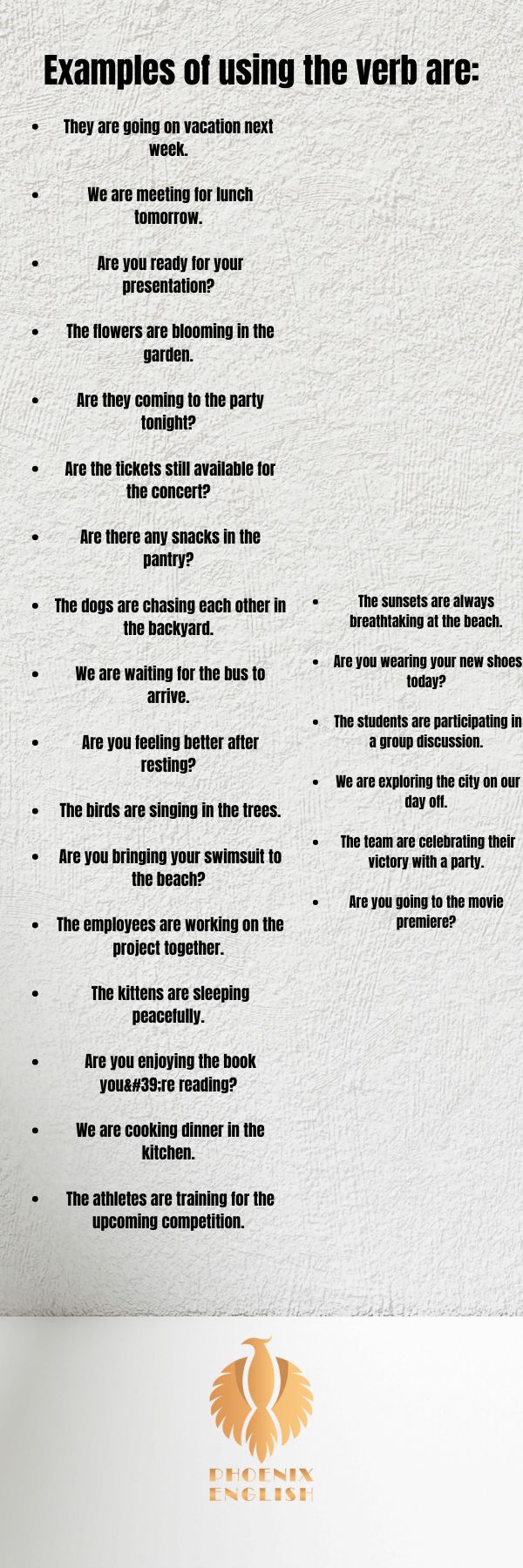In my classes, one grammar topic that often sparks confusion is understanding when to use are versus is when expressing actions or states in the first person singular. It’s essential for English learners to grasp this distinction to communicate effectively and accurately. Let’s explore the correct usage of are and is with examples to provide a clearer understanding.
You might also enjoy: Due To Or Do To? Grammar + Examples [2024]
Examples of using the verb are:

-
They are going on vacation next week.
-
We are meeting for lunch tomorrow.
-
Are you ready for your presentation?
-
The flowers are blooming in the garden.
-
Are they coming to the party tonight?
-
Are the tickets still available for the concert?
-
Are there any snacks in the pantry?
-
The dogs are chasing each other in the backyard.
-
We are waiting for the bus to arrive.
-
Are you feeling better after resting?
-
The birds are singing in the trees.
-
Are you bringing your swimsuit to the beach?
-
The employees are working on the project together.
-
The kittens are sleeping peacefully.
-
Are you enjoying the book you're reading?
-
We are cooking dinner in the kitchen.
-
The athletes are training for the upcoming competition.
-
Are you going to the movie premiere?
-
The sunsets are always breathtaking at the beach.
-
Are you wearing your new shoes today?
-
The students are participating in a group discussion.
-
We are exploring the city on our day off.
-
The team are celebrating their victory with a party.
You might also enjoy: Paid Vs Payed : Differences + Examples [My 2024 Teaching Way]
30 examples using the verb is:
1. The sky is blue.
2. She is a doctor.
3. The cat is sleeping.
4. My favorite color is green.
5. He is tall.
6. The sun is shining.
7. The book is interesting.
8. The flowers are blooming.
9. The clock is ticking.
10. Water is essential for life.
11. They are best friends.
12. The weather is warm.
13. Love is all you need.
14. Time is running out.
15. Education is important.
16. The music is loud.
17. The computer is broken.
18. Happiness is a choice.
19. The dog is barking.
20. The food is delicious.
21. The city is crowded.
22. Reading is a great hobby.
23. Life is unpredictable.
24. The painting is beautiful.
25. The movie is exciting.
26. The project is due tomorrow.
27. Family is everything.
28. The dress is on sale.
29. The traffic is heavy.
30. The team is winning.
30 differences about using is and are
1. Is is used for singular subjects, while are is used for plural subjects.
2. Is is the present tense form of the verb to be, while are is the present tense form for plural subjects.
3. Is is used with singular nouns, while are is used with plural nouns.
4. Is is used with he, she, it, or a singular noun, while are is used with they, we, you, or plural nouns.
5. Is is used in singular sentences, while are is used in plural sentences.
6. Is indicates a singular action or state, while are indicates a plural action or state.
7. In a sentence, is suggests that something exists, while are suggests that multiple things exist.
8. Is indicates an individual or single entity, while are indicates a group or multiple entities.
9. Is is used for things that are singular in number, while are is used for things that are plural in number.
10. Is is used when describing something as being singular, while are is used when describing something as being plural.
11. Is is used with singular pronouns like he, she, it, while are is used with plural pronouns like they, we, you.
12. Is implies a single entity or object, while are implies multiple entities or objects.
13. Is is used when talking about one thing, while are is used when talking about multiple things.
14. Is is used to describe a single occurrence, while are is used to describe multiple occurrences.
15. Is indicates a singular identity, while are indicates a plural identity.
16. Is implies a singular state of being, while are implies a plural state of being.
17. The verb is is followed by a singular noun or pronoun, while the verb are is followed by a plural noun or pronoun.
18. Is is used for singular verbs, while are is used for plural verbs.
19. Is is for singular subjects like she, he, it, while are is for plural subjects like they, you, we.
20. Is is used to describe one condition or situation, while are is used to describe multiple conditions or situations.
21. Is is used to indicate one specific thing, while are is used to indicate multiple specific things.
22. Is is used to talk about one individual, while are is used to talk about multiple individuals.
23. Is is used with singular objects, while are is used with plural objects.
24. Is is used when referring to one entity, while are is used when referring to multiple entities.
25. Is is used when talking about one characteristic, while are is used when talking about multiple characteristics.
26. Is is used when discussing a single idea, while are is used when discussing multiple ideas.
27. Is is used when there is only one option, while are is used when there are multiple options.
28. Is is used when referring to one thing at a time, while are is used when referring to several
things at once.
29. Is is used for singular or uncountable nouns, while are is used for plural nouns.
30. Is is used for singular verbs in the present tense, while are is used for plural verbs in the present tense.
You might also enjoy: Top 100 Commonly Used Verbs That Start With R [2024]
Navigating the Usage of Are in English Grammar

In English grammar, the verb are is a crucial element used to denote actions or states of being associated with plural subjects.
- Understanding when to correctly use are involves identifying situations where the subject of the sentence is referring to multiple entities, individuals, or things.
- For example, when talking about a group of friends playing in the park, you would say, They are having a great time.
- Here, the plural subject They aligns with the plural form of the verb are to indicate that the friends, as a collective group, are engaging in the activity of having a great time.
- Similarly, in sentences like The books are on the shelf or You are invited to the party, the plurality of the subjects (books and you) requires the use of are to accurately reflect the multiple items or individuals being referenced. By recognizing these patterns and contexts where plural subjects are present, individuals can effectively utilize are in their speech and writing to ensure grammatical correctness and clarity in communication.
Navigating the Usage of Is in English Grammar
Navigating the usage of is in English grammar entails understanding when to employ this verb form to convey actions or states of being related to singular subjects.
- When the subject of a sentence refers to a single person, object, or concept, is is the appropriate verb choice.
- For instance, in sentences like She is reading a book or The cat is sleeping, the singular subjects (She and The cat) align with the singular form of is to describe the specific actions or states associated with them.
- This alignment ensures grammatical accuracy and clarity in conveying information about individual entities or activities. By recognizing the singular nature of the subjects in such contexts, individuals can confidently utilize is in their linguistic expressions to effectively communicate in both written and spoken English.
Navigating the Usage of Are in English Writing
When navigating the usage of are in English writing, it is essential to grasp the instances where this verb form is employed to denote actions or states of being related to plural subjects.
- Are is utilized when the subject of a sentence pertains to multiple entities, individuals, or things.
- For example, in sentences like They are preparing for the presentation or The students are discussing the assignment, the plural subjects (They and The students) align with the plural form of are to signify the collective actions or activities taking place.
- By recognizing the plural nature of the subjects in such contexts, writers can ensure grammatical correctness and clarity in their prose.
- Utilizing are accurately contributes to conveying information about group actions or situations involving multiple components effectively in written English. Mastering the appropriate usage of are enhances the coherence and precision of one’s writing, enabling them to express ideas with clarity and grammatical accuracy.
You might also enjoy: Canceled or Cancelled: Grammar + Examples + Usage [2025]
Navigating the Usage of is in English Writing
Navigating the usage of is in English writing involves understanding when to utilize this verb form to convey actions or states of being associated with singular subjects.
- Is is employed when the subject of a sentence refers to a single person, object, or concept.
- For instance, in sentences like She is walking to the store or The sun is shining brightly, the singular subjects (She and The sun) align with the singular form of is to describe specific actions or conditions.
- This alignment ensures grammatical accuracy and clarity in conveying information about individual entities or occurrences.
- By recognizing the singular nature of the subjects in such contexts, writers can effectively use is in their written works to communicate ideas with precision and coherence. Mastering the appropriate usage of is enhances the fluency and accuracy of one’s writing, enabling them to express thoughts and descriptions clearly and grammatically correct.
1. What is the difference between are and is in English grammar?
The difference lies in their usage with plural subjects requiring are and singular subjects requiring is.
- In English grammar, the difference between are and is primarily lies in their usage based on the number of the subject.
- Are is used with plural subjects, referring to more than one person, thing, or entity.
- On the other hand, is is used with singular subjects, denoting one person, object, or concept.
- This distinction is crucial for maintaining subject-verb agreement in a sentence, ensuring that the verb form aligns correctly with the number of the subject.
- Understanding this difference helps writers express ideas clearly and accurately, avoiding grammatical errors that can impact the coherence of their writing.By recognizing when to use are and is appropriately, individuals can enhance the fluency and precision of their communication in both written and spoken language.
2. Provide an example where are is correctly used.
They are walking in the park.

3. Can you give an example of when to use is?
She is studying for her exam.
4. How do you determine whether to use are or is in a sentence?
Consider if the subject is singular or plural to choose between are and is.
- Determining whether to use are or is in a sentence involves considering the number of the subject being referenced.
- Here are the general guidelines to help you make the right choice:
- Are should be used with plural subjects, which refer to more than one person, thing, or entity.
For example: The birds are singing in the trees.
- Is is used with singular subjects, denoting one person, object, or concept.
- By identifying whether the subject is singular or plural, you can select the appropriate form of the verb, are or is, to ensure subject-verb agreement in your sentence. This basic grammar rule helps maintain the clarity and accuracy of your communication, reflecting a solid understanding of English grammar principles.
5. Give an example illustrating the correct use of are with plural subjects.
The birds are singing in the trees.
6. Explain Why we say The team is winning and Not The team are winning.
Team is considered a singular entity, hence requiring the singular form is.
7. Provide a sentence where is is correctly used with a singular subject.
My cat is sleeping on the couch.
8. How can the correct usage of are and is impact the clarity of a sentence?

Using the appropriate form ensures the subject-verb agreement, enhancing the understanding of the sentence.
The correct usage of are and is plays a significant role in enhancing the clarity of a sentence. When are and is are used appropriately based on the number of the subject, it ensures proper subject-verb agreement, which is essential for effective communication. Here’s how the correct usage of these verbs can impact the clarity of a sentence:
1. Avoids confusion:
Using the right form of are or is based on whether the subject is plural or singular helps avoid confusion for the reader or listener.
It provides a clear indication of the relationship between the subject and the verb.
2. Maintains coherence:
Proper subject-verb agreement contributes to the overall coherence of the sentence. When are is used with plural subjects and is with singular subjects, the sentence flows smoothly, making it easier to understand the intended message.
3. Conveys meaning accurately:
Using are or is correctly ensures that the verb aligns with the number of the subject, accurately conveying the intended meaning. This clarity prevents misinterpretation and helps get the message across effectively.
You might also enjoy: Top 100 Commonly Used Verbs That Start With C [2024]
4. Reflects language proficiency:
The accurate use of are and is showcases a good command of English grammar and demonstrates attention to detail in communication. It reflects positively on the writer’s or speaker’s language proficiency.
In conclusion, by paying close attention to the proper usage of are and is in a sentence, individuals can improve the clarity and effectiveness of their communication, leading to better understanding and interpretation of their messages.
9. Why do we say He is happy and not He are happy?

He is a singular subject, necessitating the singular verb is.
- The reason we say He is happy and not He are happy lies in the fundamental grammar rule of subject-verb agreement.
- In English, the verb is is used with singular subjects, such as he, she," it, or singular nouns. On the other hand, the verb are is used with plural subjects like they, we, or plural nouns.
- In the sentence He is happy, the singular subject he requires the singular form of the verb is to maintain proper subject-verb agreement.
- Using are instead of is would be grammatically incorrect because it would not match the singular nature of the subject.
- Therefore, adhering to the rule of subject-verb agreement is essential for constructing grammatically correct sentences in English.
By following this rule and using is with singular subjects like He, we ensure clarity and accuracy in our communication.
10. Explain when to use are in a sentence with multiple subjects.
Use are when the subject refers to more than one person, thing, or entity.
11. Give an example illustrating correct usage of is with a singular subject.
The book is on the shelf.
You might also enjoy: Top 100 Commonly Used Verbs That Start With M [2024]
12. How does the correct use of are and is contribute to effective communication?
It ensures grammatical accuracy and helps convey the intended meaning clearly.
The correct use of are and is is essential for effective communication as it helps to convey ideas clearly, maintain coherence, and ensure accurate expression of thoughts. Here are several ways in which the proper use of these verbs contributes to effective communication:
1. Clarity:
Using are with plural subjects and is with singular subjects helps to avoid confusion and clearly indicate the relationship between the subject and the verb. This clarity enables the reader or listener to easily understand the intended message.
2. Subject-Verb Agreement:
Correctly matching the subject with the appropriate form of are or
is demonstrates an understanding of subject-verb agreement. This agreement is crucial for the sentence to make sense and for the communication to be
coherent.
3. Consistency:
Consistently using the correct form of are and is throughout a piece of writing or conversation creates a smooth flow and enhances overall coherence. It shows attention to detail and helps maintain the reader or listener’s engagement.
4. Professionalism:
Using are and is accurately reflects a strong grasp of language conventions and grammar rules.
This professionalism in communication can enhance the credibility and authority of the speaker or writer.
5. Accurate Expression:
Proper use of are and is ensures that the verb aligns with the number
of the subject, leading to accurate expression of ideas. This accuracy prevents misinterpretation and conveys the intended meaning effectively.
In conclusion, mastering the correct use of are and is is crucial for effective communication. By following grammar rules, maintaining subject-verb agreement, and ensuring clarity in expression, individuals can enhance the quality of their communication and convey their thoughts accurately and
persuasively.
You might also enjoy: Top 100 Commonly Used Verbs That Start With I [2024]
13. Provide a sentence demonstrating the correct use of are with plural subjects.
The students are writing their essays.
14. Why is it important to understand the distinction between are and is in English grammar?
It helps maintain coherence and accuracy in written and spoken communication.
- Understanding the distinction between are and is in English grammar is crucial for several reasons that impact effective communication. Here are some key points highlighting the importance of grasping this difference:
1. Subject-Verb Agreement:
Proper subject-verb agreement is a fundamental aspect of English grammar.
Knowing when to use are with plural subjects and is with singular subjects ensures that sentences are grammatically correct and coherent. This understanding helps to avoid errors that can lead to confusion or miscommunication.
2. Clarity and Precision:
Using the correct form of are and is enhances clarity and precision in communication. It helps convey ideas accurately and ensures that the intended message is clearly understood by the audience. Ambiguity in subject-verb agreement can hinder effective communication and create misunderstandings.
3. Professionalism and Credibility:
Demonstrating a solid grasp of grammar rules, including the distinction between are and is, enhances professionalism and credibility in both written and spoken communication. It showcases a level of proficiency in the language and reflects positively on the speaker or writer.
4. Enhanced Writing and Speaking Skills:
Understanding the nuances of are and is enables individuals to express themselves more effectively in writing and speaking. It allows for the construction of grammatically correct sentences that flow smoothly and convey
ideas with precision. This mastery of language mechanics contributes to overall communication skills.
5. Effective Communication:

Mastery of grammar concepts such as subject-verb agreement, including the use of are and is, is essential for effective communication. Clear and accurate expression of thoughts and ideas relies on understanding and applying these fundamental rules of English grammar.
In conclusion, the distinction between are and is in English grammar is important for maintaining coherence, clarity, and accuracy in communication. By recognizing and applying these differences appropriately, individuals can enhance their language skills and convey their messages more effectively.
15. Give an example where is is correctly used with a singular subject.
The sun is shining brightly in the sky.
16. How does the usage of are differ from is in terms of subject-verb agreement?
Are corresponds to plural subjects, while is corresponds to singular subjects.
- The usage of are differs from is in terms of subject-verb agreement based on whether the subject is plural or singular.
- Understanding this distinction is essential for constructing grammatically correct sentences in English. Here is how the usage of are and is varies in terms of subject-verb agreement:
1. Are with Plural Subjects:
The verb are is used with plural subjects, such as they, we, you, or any subject that refers to more than one person, place, or thing. For example:
– They are going to the park.
– We are studying for our exams.
– The students are listening to the lecture.
2. Is with Singular Subjects:
The verb is is used with singular subjects, such as he, she, it, a singular noun, or any subject that refers to one person, place, or thing. For example:
– She is reading a book.
– He is a doctor.
– The cat is sleeping on the sofa.
3. Subject-Verb Agreement:
Subject-verb agreement ensures that the verb matches the number of
the subject in a sentence. Using are with plural subjects and is with singular subjects maintains this agreement and helps to convey the intended meaning clearly.
4. Consistency in Communication:
Consistently using are with plural subjects and is with singular subjects throughout a piece of writing or conversation helps maintain consistency and
coherence in communication. It shows a command of language rules and enhances the overall quality of the message.
5. Clarity and Accuracy:
By correctly matching the verb are or is with the appropriate subject, speakers and writers can ensure clarity and accuracy in their communication. This precision in subject-verb agreement helps to avoid confusion and effectively convey ideas.
In conclusion, understanding the usage of are with plural subjects and is with singular subjects in terms of subject-verb agreement is essential for constructing grammatically correct sentences. By applying this knowledge, individuals can communicate more effectively and convey their thoughts and ideas accurately in English.
You might also enjoy: Top 100 Commonly Used Verbs That Start With K [2024]
17. Explain the difference in meaning between They are studying and He is studying.
The former refers to multiple individuals studying, while the latter denotes a single person studying.
18. Provide an example illustrating the correct use of is with a singular subject.
The flower is blooming beautifully in the garden.
19. How can understanding when to use are and is improve one’s writing skills?
It enhances the writer’s ability to form grammatically correct sentences and convey ideas effectively.
- Understanding when to use are and is is crucial for improving one’s writing skills in several ways.
- Mastery of these basic grammar concepts can enhance the clarity, coherence, and overall quality of written communication.
- Here are some key points on how understanding the usage of are and is can benefit one’s writing skills:
1. Grammar Accuracy:
Correctly using are with plural subjects and is with singular subjects
ensures proper subject-verb agreement in sentences. This adherence to grammar rules enhances the accuracy of writing and helps to avoid common
errors that can detract from the overall quality of the text.
2. Sentence Structure:
Understanding when to use are and is contributes to the structural integrity of sentences. By applying these verbs appropriately based on the number of the subject, writers can construct grammatically sound sentences that flow smoothly and make their writing more coherent and organized.
3. Clarity and Precision:
Using the appropriate form of are or is helps writers convey their ideas with clarity and precision. By matching the verb to the subject correctly, they can avoid ambiguity and ensure that their messages are clearly understood by readers. This clarity enhances the overall effectiveness of
the writing.
4. Professionalism and Credibility:
Demonstrating a solid grasp of grammar rules, including the distinction between are and is, can enhance the professionalism and credibility of one’s writing. Writers who exhibit a mastery of language mechanics are perceived as more competent and reliable, which can positively impact the reception of their work.
5. Enhanced Communication Skills:
Proficiency in using are and is appropriately reflects a broader competency in English language skills. By mastering these basic grammar concepts, writers can improve their overall communication skills, including writing, speaking, and comprehension, which are essential for both academic and professional success.
In conclusion, understanding when to use are and is in writing is essential for improving one’s writing skills. By mastering these fundamental grammar concepts, writers can enhance the accuracy, clarity, and professionalism of their writing, ultimately leading to more effective communication and a stronger
impact on their audience.
20. Can you explain a situation where confusion between are and is could lead to misunderstanding?
Misusing are with singular subjects or is with plural subjects may lead to ambiguity and misinterpretation of the intended message.
- Confusion between are and is can lead to misunderstanding in various situations, especially when the subject-verb agreement is critical for accurate communication.
- Here is an example scenario where such confusion could occur:
- Imagine a team of employees is working on a project together, and a team leader is providing instructions to the group.
- The team leader intends to convey that all team members are responsible for completing specific tasks.
- However, if there is confusion between are and is in the instructions, it can lead to
misunderstanding among the team members.
- Incorrect Sentence: The Team members is responsible for Submitting the Reports.
- In this case, using is instead of are creates subject-verb disagreement because team members is a plural subject.
- This incorrect sentence might lead team members to believe that only one individual is responsible for submitting the reports, causing confusion and potentially resulting in tasks not being completed as intended.
- Corrected Sentence: The Team members are responsible for submitting the Reports.
- By using are to match the plural subject team members, the sentence conveys the accurate message that all team members share the responsibility for submitting the reports.
- This correction eliminates ambiguity and ensures that the instruction is clear and understood correctly by the team members.
- In this scenario, the confusion between are and is can undermine effective communication within the team, leading to misunderstanding, inefficiency, and potential breakdowns in collaboration. Therefore, understanding and applying the appropriate usage of are and is in such contexts is crucial for maintaining clarity and coherence in communication, particularly in group settings where collective
actions or responsibilities are involved.
You might also enjoy: Top 100 Commonly Used Verbs That Start With V [2024]
Conclusion:
In conclusion, mastering the correct usage of are and is in the first person singular is a fundamental aspect of English grammar.
By practicing with examples and understanding the nuances between these two forms, students in my classes can enhance their language skills and express themselves with precision. Have you encountered any challenges with using are and is in your own writing or conversations?

Hi, welcome to my blog! My name is Omid and I am thrilled to have you here! I am an English language teacher with 12 years of experience and hold multiple international certifications (TESOL, IELTS, TOEFL, PTE, CELTA). Additionally, I hold a PhD in Applied Linguistics with a specialization in Teaching English as a Second Language (TESL), which fuels my passion for teaching English and assisting others in mastering the language. To me, nothing is more rewarding than helping individuals enhance their English language abilities through various methods. So, let’s embark on this journey of learning English together.

![an featured pic about Are vs Is Correct usage + Examples [2024 update]](https://phoenixenglishlang.com/wp-content/uploads/2024/08/Are-vs-Is-Correct-usage-Examples-2024-update.jpg)


